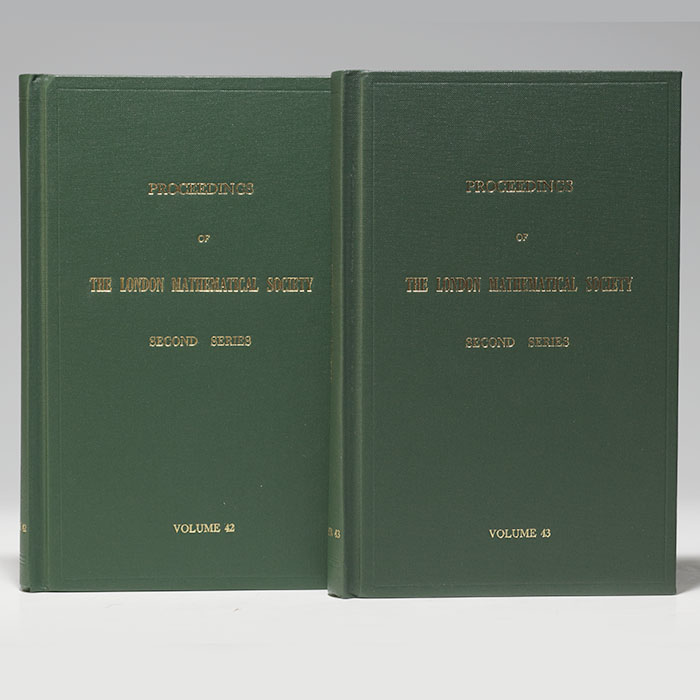
THE DAWN OF THE COMPUTER AGE: “IT IS POSSIBLE TO INVENT A SINGLE MACHINE WHICH CAN BE USED TO COMPUTE ANY COMPUTABLE SEQUENCE”—TURING’S LANDMARK PAPER ON COMPUTABLE NUMBERS, 1936 FIRST EDITION
TURING, Alan Mathison. "On Computable Numbers, with an Application to the Entscheidungsproblem." IN: Proceedings of the London Mathematical Society, Second Series, Volume 42 and Volume 43, Parts 3, 4 and 7, pp. 230-240; 241-265; 544-546. London: for the Society, November 30 and December 23, 1936 (parts 1 and 2 of Turing's paper) and April 22, 1937 (correction). Two volumes. Octavo, modern green cloth; portions of wrappers bound in. $28,500.
First appearance of the concept of the universal computing machine, which would come to be known as a Turing machine: “it is possible to invent a single machine which can be used to compute any computable sequence.” Complete with the scarce “correction” or third part of this important paper, issued a year after the first two parts and often not present.
"Computing is normally done by writing certain symbols on paper… [But] I think that it will be agreed that the two-dimensional character of paper is not essential of computation" (page 249). David Hilbert, one of the greatest mathematicians of his age and one of Turing's academic forerunners, posed a series of problems, the last of which was his "Entscheidungsproblem," the core of which dealt with whether there was a definite method or "mechanical process" that could be applied to any mathematical assertion and which would always produce a correct answer as to whether the assertion was true or false. In the pre-computer age, this was a matter for philosophy and theoretical mathematics. Yet, Turing had an inkling that the future promised something greater and more exact. More than any other individual, Turing created the theoretical foundation for digital computers developed in the 1940s. "While at Princeton [as a graduate student] Turing published one of his most important contributions to mathematical logic, his 1936-37 paper 'On Computable Numbers…' which immediately attracted general attention. In it he analyzed the processes that can be carried out in computing a number to arrive at a concept of a theoretical 'universal' computing machine (the 'Turing machine'), capable of operating upon any 'computable' sequence—that is, any sequence of zeros and ones" (DSB). The definition, in fact, of "computable" is that the problem can be solved by a Turing machine; this concept of a Turing machine, which could theoretically perform any mathematical calculation, was important in the development of the digital computer. "In showing that a universal machine was possible, Turing's paper was highly influential in the theory of computation, and it remained a powerful expression of the virtually unlimited adaptability of electronic digital computers" (Hook & Norman, Origins of Cyberspace, 394—their copy without the third part). The third part of Turing's paper, rare and present here, is a correction, issued in April of 1937 in response to errors found by Paul Bernays, a Swiss mathematician. Each of the three parts of this important paper appears in the complete journal in which it was originally issued. Last leaf of correction (Volume 3, page 545-46) misbound so sequence of correction is 544, 546, 545.
Tape reinforcement to verso of Volume 42 title page, slight soiling and a few creases to interior but generally quite nice, cloth fine. A scarce item in nearly fine condition.